


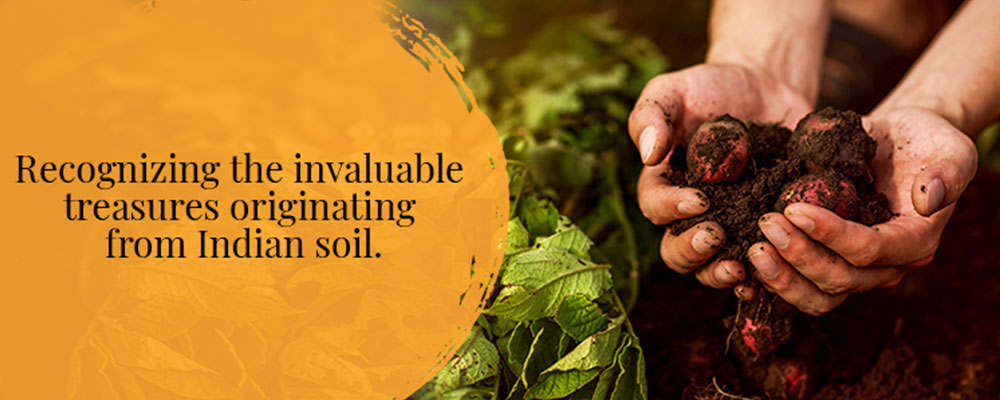


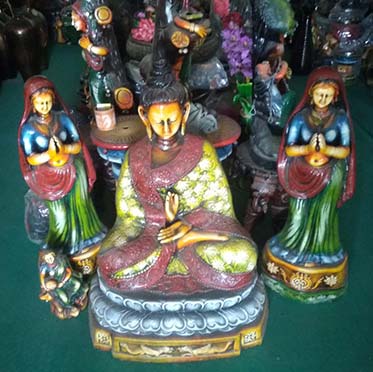
Gorakhpur Terracota
Gorakhpur Terracota is an age old craft of the Gorakhpur region and it is largely spread over the villages of Padri Bazar, Belwa Raipur,Jungle Ekla No-1, Jungle Ekla No-2 in Chargawan block and Aurangabad, Bharwalia, Langadi Gularia, Budhadih, Amawa, Ekla etc in Bhathat block of Gorakhpur. The art could not spread forward since it required clay of specific type which was found in the ponds present in these areas.
The craftsmen belong to ‘Prajapati’ caste, the Terracotta craft of Gorakhpur is an example of traditional art form thriving over generations. The craftsmen make various animal figures like, horses, elephants, camel, goat, ox etc with hand applied ornamentation. For this, refined clay is partially dried & cast, moulded or hand worked into desired shape. After drying it thoroughly, it is placed in a kiln & fired. Then the hot ware is covered with sand to cool. Some of the major products of craftsmanship include animal motifs like elephant Table, Hauda elephants, Mahawatdar horse, Deer, Camel etc. Further religious idols like Five-faced Ganesha, singled-faced Ganesha, ,Musical troupe of humans & Ganesha are also quite common. Other decorative items like camel cart, bullock-cart, horse-cart, camel-lamp, lantern, chandeliers, Hanging bells etc. are also popularly showcased. View Vendor List...

LUCKNOW CHIKAN CRAFT
Lucknow Chikan Craft is handiwork skill based craft. It is a type of embroidery on white fabric with white thread, with predominantly floral designs executed on fine cotton with untwisted threads of white cotton, rayon or silk. Chikankari is something like unity in diversity i.e. it includes some simple and complex stitches giving it an effect, which is simple, gentle and delicate.
The process of Chikankari undergoes five different stages, namely cutting, stitching, printing, embroidery, washing and finishing. The most common motif used is that of a creeper. Individual floral motifs may embellish the entire garment or just one corner. The different products manufactured by artisans include Caps, Chapkan, Angrakha, Kurta, Kurta-Kameez, Applique angrakha, Chikan T-shirt Kurta and Embroidered Sherwani. View Vendor List...



LUCKNOW ZARDOZI
Zardozi works are a range of embroidery products done by the devoted artisans.
Zardozi work has two distinct categories known as Karchobi and kamdani. The embroidery done on velvet or heavy satin generally for tent coverages, furnishings, etc. traditionally with badla was called Karchobi.
Kamdani generally refers to the work done on muslin, silk and other fabrics. The work here is done with great deal of minute skill in delicate rhythm. This technique remained more popular on the dresses, coverlets, caps and many miscellaneous items.
The process of zardozi revolves around five basic designs which have larger variation. These basic designs are jail (geometric design) (Line-drawings 56-70), bharat (filler design) (Line-drawings 71-76), patti (leaf), phul (flower), pankhi (bird), janwar (animal).
The Zardozi products incudes cane scabbards for swords and daggers, canopies, coats, caps, ghagras, covers for boxes, combs and mirrors, umbrellas, fans, shoes, bags, belt, saddle cloths, seat covers, carpets, bolsters, etc. and a variety of other objects. The artisans are also performing embroidery on saris, suits, dupatta, and lahenga, Jackets, shirts, long skirts, and longer scarves, etc. View Vendor List...

WOODEN HANDICRAFT OF SAHARANPUR
The history of wooden handicraft industry in Saharanpur dates back to 400 years back in Mughal era when some craftsman from Kashmir came back and settled in Saharanpur in search of bread and butter and eventually settled in the city to make the craft known worldwide as the Wooden Carving Industry of Saharanpur. With the seat of Mughal empire and the British in Delhi and the royalty associated with the classic wooden handicrafts, Saharanpur could develop itself as an industry overtime with generations of families becoming a part of this trade.
In 2014, the industry was given a GI tag. Initially, the industry was limited to household carving done on Sheesham wood which would be readily available in Saharanpur and the finished product would be supplied to markets of Delhi and Lucknow, but overtime with increased demand the use of wood like Mango and Keekar also grew with greater mechanisation. The products manufactured here still preserve with it the fragrance of years of heritage and history and the intricate handwork of the labourers. The products range from furniture, wall decors, wooden panels, antiques, gift items etc. In this endeavour of Atmanirbhar Bharat, the wooden handicraft of Saharanpur can serve as an important substitute to multiple imports and an attempt to regain the old glory of the city. View Vendor List...



BANARAS GULABI MEENAKARI CRAFT
The pink enamel (Gulabi Meenakari) was brought to India by Persians in the 17th century during the Mughal period, attained its peak in Persian court during Qajar dynasty. The Banaras specialty is its Pink Meena on white enamel and often employs a lotus motif. Many people work on the product - goldsmith, ghaaria (engraver), the chitteria (designer), and jadiya who applies the gems on the gold.
Meenakari, also called enamelling, is the art of decorating a metal surface by fusing mineral substances on it. The process is often applied to kundan—articles of jewelry studded with gemstones set with a layer of gold foil between the stone and the mount on one side, while the reverse is lavishly enamelled using the meena technique. The luster of the meena increases over time due to contact with the wearer’s body and clothes.
The brilliance of the diamonds and other stones is effectively complemented by the multihued enamel of the meena. The present meenakars in Varanasi claimed that the position of the art of meenakari was prosperous till about hundred years ago. Now only a few artisans are involved in an otherwise flourishing industry of the past. View Vendor List...

CHUNAR BALUA PATTHAR
Chunar Balua Patthar is the second GI registered under natural goods category in the country. Bhartihari, the ruler of ancient Ujjain who came here for penance and built a grand fort here with Chunar Sand Stone, is a classic example of human skill with their uniqueness on the bank of holy river Ganga.
The National Emblem of India the "Ashoka Chakra" is taken from Ashoka Pillar of Sarnath which has made by Chunar Sand Stone is a unique example of their strength, quality and composition from beginning of 250 BC. View Vendor List...



ghazipur wall hangings
Ghazipur wall hangings are interior decor items that are handcrafted in the small city of Ghazipur in Uttar Pradesh. These traditional handloom products are woven by skilled craftspeople with the help of simple sketch diagrams and involve techniques like: Hand-woven in pit loom (without Jacquard), Rapping with embroidery and Pasting work. They combine different yarns including jute and cotton, and use a blend of different colors to ensure not only strength but also an unusual unique texture.
The use of differing textures also forms part of the presentation of the patterning and design. These Ghazipur wall decorative hangings are woven on the handloom and their intricate patterning, colors and designs have wide appeal. A large range of designs bears testimony to the skill of the weavers, from representation of figures of Hindu gods and goddesses to intricate and detailed landscape arts with patterns of houses, lawns, forests, interiors, birds and animals.
The major production area is Devkali block and Saidpur of Ghazipur district and in Varanasi, Chandauli, Mirzapur districts of Uttar Pradesh.View Vendor List...

HANDMADE CARPET OF Bhadohi
This type of the hand-knotted carpet is manufactured on a vertical wooden loom by a unique weaving technique: with the use of knots, iron punja. Thick cotton and woolen yarns are used in the warp ends while wool is used in the width direction. These looms are equipped with a double layer of warp ends separator rods and platforms.
Designs depicting flowers, animals, gardens, trees and trellises are used in various hues and ways to liven up these floor coverings. The production process commences with the selection of woolen yarns which are generally bought from domestic and international circuits.
The wool used in carpets varies according to the quality, design and style and so do the colours. The original place of Bhadohi carpet has emerged from village Madho Singh Ghosia. View Vendor List...


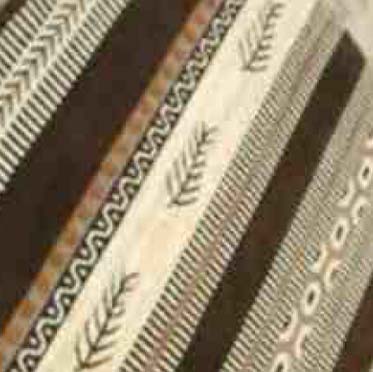
MIRZAPUR HANDMADE DURRIES
The Mirzapur Handmade Durrie is one among a multitude of styles of floor coverings. They are defined essentially by the use of the “Panja” for weaving, and are also known for their fairly bold colors and patterns.
Mirzapur Handmade Durries are woven in a weft faced plain weave on simple horizontal looms. Woolen yarns are mostly used; this gives them a sturdy and flat appearance. The mix of traditional and contemporary designs is evidence of a high degree of workmanship. The uniqueness of Mirzapur Handmade Durries lies in the fact that the whole process is entirely manual, starting from designing and weaving to finishing. View Vendor List...

VARANASI SOFT STONE JALI WORK
With the support of King of Varanasi, this Jali work craft emerged around the Ramnagar Fort area. Today the 4th generation craftsmen are working here. The artisans mostly belong to SC and OBC castes. They make them in accordance with their own perspective of history and mythology.
Jali or fretwork is intricately carved on soft stone (monolithic, and without any joints) and its process requires supreme mastery of masonry and design making. The Varanasi jali work epitomizes both high skill and superior quality of craftsmanship. Delicately chiseled and decorated with inlay work these elaborately carved jalis demand time in their making along with the skill and creativity.
The jali craft work can be seen on forts, zamindari homes, places of worship and ancient monuments all of which are a testimony of its antiquity. Statues of religious significance are also made using this technique. To further enhance the beauty of these sculptures they would be embedded with semi-precious stones and shell- work. Today small items of utility and decor are also produced such as table tops, boxes, coasters, trays, etc. The popular ‘Elephant within Elephant’ and other such pieces of Birds, animals, statues, etc are the result of the skills and sheer hard work of these craftsmen. View Vendor List...



VARANASI WOODEN LACQUERWARE & TOYS
Varanasi and Mirzapur in Uttar Pradesh are famous for their wooden lacquer ware and wooden toys. The craftsmen here claim to belong to the Kunder Kharadi Samaj. It is an ancient craft and Varanasi has been a major center for the same. Sal or sheesham is the raw material used. Designs are created with the natural veins of the wood. These toys are made without any joints, and are attractive and safe playthings for children. The colours used are bright and primary. Kashmiri Ganj and Khojwa are the major centers of production. The toys have a ritual significance also and are not made just for play.
This craft plays a pivotal role in the lives of the artisans, since when a child is born a new lathe is added to the family possessions. In fact, when a marriage is being fixed the boy’s family makes sure that the bride-to-be is familiar with the lathe. Sets of birds, animals, musicians and dance ensembles are also available packed in boxes. View Vendor List...

MANGO MALIHABADI DUSSEHERI
Malihabadi dusseheri is a variety with fibreless flesh and with pleasant flavour and taste. Mango Malihabadi Dusseheri has a small to medium sized fruit with elongated shap, which is yellow.
Dusseheri ripens after 6-7 days of harvesting at maturity and it stays for 5 days after ripeining. Dusseheri mango grows well in tropical climate. The ideal temperature range flowering. Rain during flowering is derimenatal to the crop as it interferes with pollination. In color, right characteristic flavour and good keeping quality. View Vendor List...


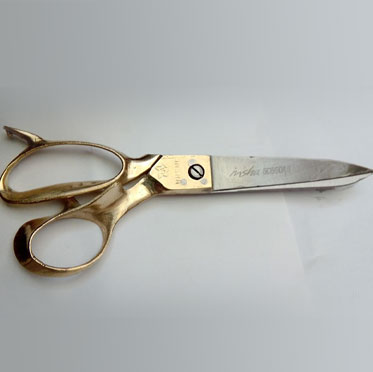
Meerut Scissors
Meerut Scissors GI does not pertain to a specific Gram Panchayat or village or hamlet. It brings into its fold all the manufacturers residing in the district belonging to ‘manufactured’ category of GI products.
Meerut Scissors are entirely made from scrap metal and by hand. Manufacturers use ‘kamani’ (spring steel) bought from the railways or automobile industries making the input cost lower than fresh metal stocks at the same time contributing towards recycling of metal waste.
The scissors are known for their sharpness, sturdiness, reparability or reusability, ergonomic design, smoothness and casted brass handle. The industry manufacturing betel nut crackers, razors and scissors is one of the oldest dating back three centuries (360 years) in the district of Meerut. The scissors industry per se is approximately ninety years old; manufacturers having inherited the craft from their ancestors. View Vendor List...

BANARAS METAL REPOUSSE CRAFT
The craft is socio-culturally associated with the people of Banaras due to its generational legacy. It is now the 5th generation that is working in this area. In Varanasi, this art is mainly practiced by the Kasera Community in the Kaashipura area. The unique repoussé technique is sometimes referred to as ‘chasing’, or embossing (Khal - Ubhar Ka Kaam). The art has been preserved in the lanes (gali) of old Varanasi for generations, making various type of faces of God & Goddess, Gold and Silver dresses, traditional ornaments, doors and wall decoration in the temples, gold and silver utensils.
In the Mahakumbh Mela – Rath, Singhasan, Hauda, Chhatra, Chawar, Dand and other related products are available. Nearly 500 metal artisans are still working and few are much popular in the country for their exclusive work in the various important temples like Shree Kashi Vishwanath Temple, Golden Temple Amritsar, Tarn Taarn Gurudwara, Jain temple at Shravanbelgola, etc. View Vendor List...
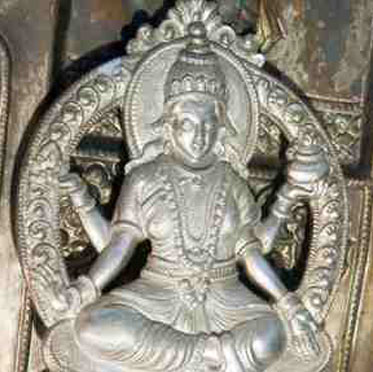


VARANASI GLASS BEADS
Varanasi is the oldest glass bead manufacturing Hub in modern India since 1940. It has the largest glass bead exports from India and has the biggest number of skilled artisans for the same. Archeological findings indicate that: 2000 yrs old glass making evidences have been found near Basti (UP) and that by 1000 BC glass bead making started in northern India. This craft is complete handicraft as it involves minimal intervention of tools. The craftsmanship has been passed mostly orally from one generation to the other (nearly 3 lakh design exist in Varanasi). Two type of producers exist here: small scale industries and artisans working from home with their own resources.
Different types of beads are used to ornament various products like clothing, decorative items, curtains, purses, clothing accessories, jewelry. More than 2,000 artisans are involved in bead production and handicrafts in Varanasi, with most of them being concentrated in the areas of Chandpur, Kandwan and Ramnagar. Major products include earrings, bracelets and neck pieces made out of multi colored glass beads. View Vendor List...

BANARAS BROCADES & SAREE
Banaras Brocades and Sarees are hand-made using finely woven silk, cotton and decorated with intricate designs using zari (gold and silver thread); this ornamentation is what makes the sarees heavy. Their special characteristics are Mughal-inspired designs/elements such as intricate floral and foliate motifs, such as kalga and bel. Other features are compact weaving, and figures with small details, metallic visual effects, ‘jali’ (a net-like pattern) and ‘meena’ work. Various types of sarees like Jamdani, Jangla, Jamwar, Tanchoi, Tissue, Cutwork, Butidaar, Sifon are traditional popular designs. Brocades like Kimkhab, Gyaser, Gyanta, Thanka, Pemachandi, Badalchandi are popular.
This art flourished during the Vedic times, reached its zenith during Mughal period and is mentioned in historical records like Jataka, Pali texts, texts by Patanjali and more recently District Gazetteers during British rule. Initially, Muslims practiced it but now both Hindus and Muslims are involved. The original Banaras weaving techniques is Kadhua weaving but due the demand of products now the Fekua weaving are used here with the support of Jacquard and Shuttle. In past, the whole technique was without Jacquard with support of Akra-Manda, Naka-jala-taka and this was the rarest handwoven method. Around 22 steps involving up to 17 people are used to make one finished product. Now a variety of stoles (dupatta) and other items are also made using this unique exotic method. View Vendor List...





